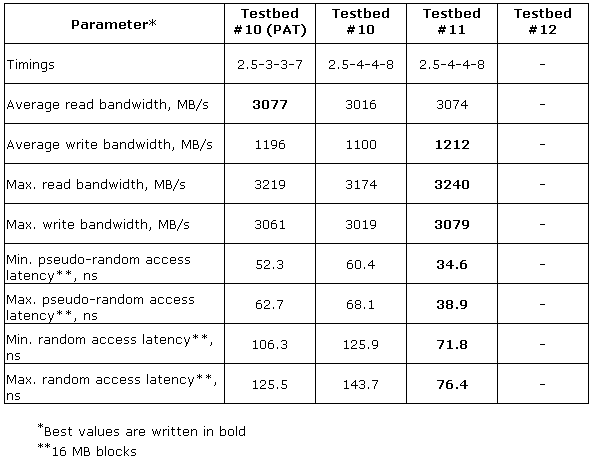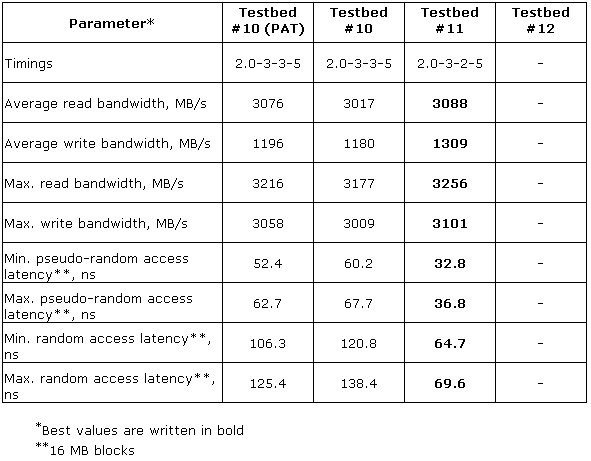Test Results
According to our method, the memory modules were tested in two modes. The first series of tests (performance tests) were carried out in normal mode, with standard timings set in motherboard BIOS according to the SPD chip data. The second series (stability tests) – in the "extreme" mode with maximum possible timings for a given module on a given motherboard.
Tests in dual channel mode
Performance tests

The first series of tests in dual channel mode was carried out with "standard" settings – memory operating in DDR-400 mode, timings being set "by SPD". You can easily see that different BIOS versions on different motherboards interpret data in this chip differently. Most of them "agree" to 2.5-4-4-8, being the true values for these modules operating at 200 MHz – we have already shown that above. Enabled PAT (Testbed #1) slightly pulls up timings (up to 2.5-3-3-7), while the on-board memory controller of AMD64 (Testbed #8) ignores tRAS and sets its own value (2.5-4-4-6). But, running a few steps forward, we can note that it's not very successful – most likely, Kingmax DDR-466 modules (like the majority of other modules) simply ignore this parameter in chipset settings and use their own values. Quite an unexpected result is demonstrated by the Gigabyte K8NS Ultra-939 motherboard based on nForce3 250 chipset (Testbed #9)... to be more exact, the lack of result! The memory modules just refused to operate with this motherboard for some unclear reason, taking into account that the memory controller is part of an AMD Athlon 64 processor, not part of a chipset. We are only to guess that BIOS of this motherboard modifies some settings of the integrated memory controller (for example, memory interleaving) different from those used by BIOS in ASUS A8V Deluxe (Testbed #8).
Let's proceed to test results. Among the testbeds of the same type (Testbeds #1 – 7, except for the AMD system) the leadership both by memory bandwidth and by latency is taken by Albatron PX865PE Pro (Testbed #1) with enabled PAT. The second place is occupied by ASUS P5P800 (Testbed #3), which also uses the memory performance acceleration technology. Putting aside these results, we can see that almost all platforms based on Pentium 4 demonstrate more or less equal results: maximum memory read bandwidth is within 6150-6200 MB/sec, pseudo-random memory access latency is within 55-65 ns. But there are exceptions: ASUS P4P800-VM (Testbed #2) is obviously lagging behind by latency (60-70 ns).
Athlon 64 based system (ASUS A8V Deluxe, Testbed #8) expectedly keeps aloof. Its distinctive features are a considerably higher maximum real memory write bandwidth, and consequently lower pseudo-random access latency (only 34-38 ns).
Stability tests
The second series of tests was carried out with minimum possible timing values not resulting in memory glitches.

From this table you can clearly see that you can set any tRAS timing value in config registers of the chipset (up to 4 inclusive) without ruining memory operation stability. Values of the other timings are the same for all tested systems – 2.0-3-3. Note that the modules under review can operate at lower timings – 2.0-3-2, but it practically immediately resulted in read/write errors (it should be noted that the number of these errors was considerably less in Testbed #8 with Athlon 64 processor). What concerns low level characteristics of the memory system – it's easy to see that switching to the "extreme" mode didn't change the disposition. With PAT enabled, Testbeds #1 and #3 are still leading by their memory bandwidth and latency (among the "equal", that is excluding the AMD system). The other motherboards demonstrate average results, except for ASUS P4P800-VM (Testbed #2), which is loosing by its pseudo-random memory access latency.
Tests in single channel mode
Performance tests

Test conditions of the first series of tests in single channel mode match those in the dual channel mode – all settings are by default. Albatron PX865PE Lite Pro (Testbed #10) acts like the "dual channel" model (Testbed #1) – when PAT is enabled, "tougher" timings are set (2.5-3-3-7). nForce 3 250 chipset again brings a surprise, this time it's EPOX 8KDA3J (Testbed #12) that won't work. There is no sense in comparing the values in this case – they will only demonstrate obvious differences in memory system characteristics with and without PAT as well as no less obvious differences between the integrated memory controller in AMD64 and the controller in the i865PE chipset.
Stability tests

Stability tests in the single channel mode reveal some differences from the test results in dual channel mode. Namely, we managed to set 2.0-3-2 memory timings in Athlon 64 system retaining system stability! (remember that this configuration in dual channel mode resulted only in reduced number of glitches).
Bottom line
First of all, we should dwell on the compatibility issue of Kingmax DDR-466 memory modules with motherboards based on various chipsets. So, these modules are not recommended to use with motherboards based on NVIDIA nForce3 chipsets (both in single and in dual channel mode), because you risk to jeopardize your memory system stability (it may even result in complete inoperability). What concerns the other motherboards and chipsets tested (VIA K8T800/Pro, i865PE/G, i915P/G), we can say that they demonstrate approximately the same stability results (minimum timings, in particular). We should name Albatron PX865PE Pro (Testbed #1) and ASUS P5P800 (Testbed #3) as obvious leaders in memory system performance due to PAT support, while the worst result was demonstrated by ASUS P4P800-VM (Testbed #2), which is characterized by high memory latencies.
Write a comment below. No registration needed!




